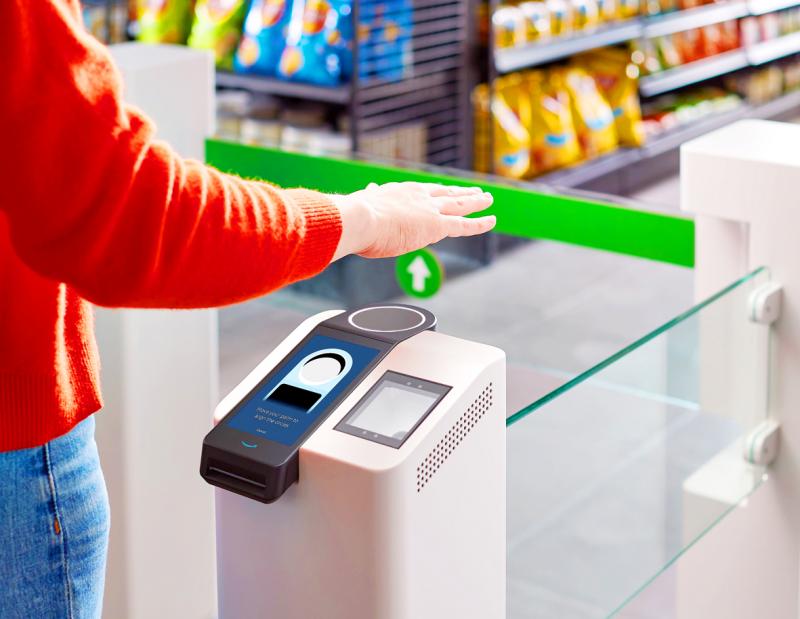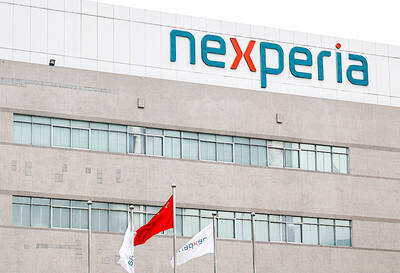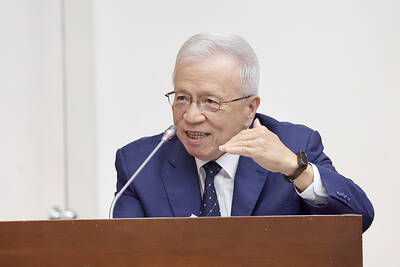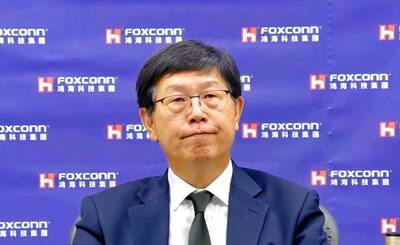Amazon.com Inc on Tuesday unveiled a new biometric payment system using palm recognition, to be made available to rival retailers, and also promoted as a replacement for badge entry at stadiums or workplaces.
The system called Amazon One was touted as “a fast, convenient, contactless way for people to use their palm to make everyday activities like paying at a store, presenting a loyalty card, entering a location like a stadium, or badging into work more effortless.”
It would be installing the system at its Amazon Go retail locations, starting with two stores in its hometown of Seattle, Washington, the US technology giant said.

Photo: AFP / AMAZON
Amazon vice president Dilip Kumar said that the system was developed as “a quick, reliable, and secure way for people to identify themselves or authorize a transaction while moving seamlessly through their day.”
Amazon One uses each individual’s “unique palm signature,” an alternative to other biometric identifiers such as fingerprint, iris or facial recognition.
“No two palms are alike, so we analyze all these aspects with our vision technology and select the most distinct identifiers on your palm to create your palm signature,” Kumar said in a blog post.
In Amazon Go stores, the palm-waving system would be added to the store’s entry gate as an option for shoppers.
“In most retail environments, Amazon One could become an alternate payment or loyalty card option with a device at the checkout counter next to a traditional point-of-sale system,” Kumar added.
The company said that it was “in active discussions with several potential customers,” which could include other retailers, but offered no details.
The announcement comes amid rapid growth in the use of biometric payments ranging from fingerprint verification on smartphones to more sophisticated systems using facial recognition.
China’s Alipay (支付寶) — the financial arm of e-commerce giant Alibaba Group Holding Ltd (阿里巴巴) — has been using a “Smile-to-Pay” system, with a machine roughly the size of an iPad, for retailers.
The shift has also raised privacy concerns about how biometric data would be safeguarded and protected from hackers.
Amazon said that the biometric data would be “protected by multiple security controls and palm images are never stored on the Amazon One device,” but send to a “highly secure area we custom-built in the cloud.”
Separately, Amazon defended its warehouse safety record after a news investigation pointed to a higher-than-average injury rate in the firm’s logistics operations.
A report released by the Center for Investigative Reporting’s Reveal project found that Amazon fulfillment centers recorded 14,000 serious injuries last year requiring days off or job restrictions.
The report, citing internal documents, concluded that the overall rate of 7.7 serious injuries per 100 employees was 33 percent higher than in 2016 and nearly double the industry standard.
The Reveal report, based on data from 2016 through last year from more than 150 US-based Amazon warehouses, said that Amazon’s claims on workplace safety belied the statistics.
Responding to the report, Amazon strongly denied misleading the public and said that Reveal’s interpretation of the data was wrong.
“We strongly refute the claims that we’ve misled anyone. At Amazon, we are known for obsessing over customers — but we also obsess about our employees and their safety,” the firm said in an e-mail.
Amazon said that Reveal was “misinformed” regarding a safety metric of the US Occupational Safety and Health Administration.
The company said that there is no industry standard on “serious incident rate,” and that using that metric distorts Amazon’s policy, which “encourages someone with any type of injury, for example, a small strain or sprain, to stay away from work until they’re better.”

JITTERS: Nexperia has a 20 percent market share for chips powering simpler features such as window controls, and changing supply chains could take years European carmakers are looking into ways to scratch components made with parts from China, spooked by deepening geopolitical spats playing out through chipmaker Nexperia BV and Beijing’s export controls on rare earths. To protect operations from trade ructions, several automakers are pushing major suppliers to find permanent alternatives to Chinese semiconductors, people familiar with the matter said. The industry is considering broader changes to its supply chain to adapt to shifting geopolitics, Europe’s main suppliers lobby CLEPA head Matthias Zink said. “We had some indications already — questions like: ‘How can you supply me without this dependency on China?’” Zink, who also

At least US$50 million for the freedom of an Emirati sheikh: That is the king’s ransom paid two weeks ago to militants linked to al-Qaeda who are pushing to topple the Malian government and impose Islamic law. Alongside a crippling fuel blockade, the Group for the Support of Islam and Muslims (JNIM) has made kidnapping wealthy foreigners for a ransom a pillar of its strategy of “economic jihad.” Its goal: Oust the junta, which has struggled to contain Mali’s decade-long insurgency since taking power following back-to-back coups in 2020 and 2021, by scaring away investors and paralyzing the west African country’s economy.

BUST FEARS: While a KMT legislator asked if an AI bubble could affect Taiwan, the DGBAS minister said the sector appears on track to continue growing The local property market has cooled down moderately following a series of credit control measures designed to contain speculation, the central bank said yesterday, while remaining tight-lipped about potential rule relaxations. Lawmakers in a meeting of the legislature’s Finance Committee voiced concerns to central bank officials that the credit control measures have adversely affected the government’s tax income and small and medium-sized property developers, with limited positive effects. Housing prices have been climbing since 2016, even when the central bank imposed its first set of control measures in 2020, Chinese Nationalist Party (KMT) Legislator Lo Ting-wei (羅廷瑋) said. “Since the second half of

AI BOOST: Next year, the cloud and networking product business is expected to remain a key revenue pillar for the company, Hon Hai chairman Young Liu said Manufacturing giant Hon Hai Precision Industry Co (鴻海精密) yesterday posted its best third-quarter profit in the company’s history, backed by strong demand for artificial intelligence (AI) servers. Net profit expanded 17 percent annually to NT$57.67 billion (US$1.86 billion) from NT$44.36 billion, the company said. On a quarterly basis, net profit soared 30 percent from NT$44.36 billion, it said. Hon Hai, which is Apple Inc’s primary iPhone assembler and makes servers powered by Nvidia Corp’s AI accelerators, said earnings per share expanded to NT$4.15 from NT$3.55 a year earlier and NT$3.19 in the second quarter. Gross margin improved to 6.35 percent,